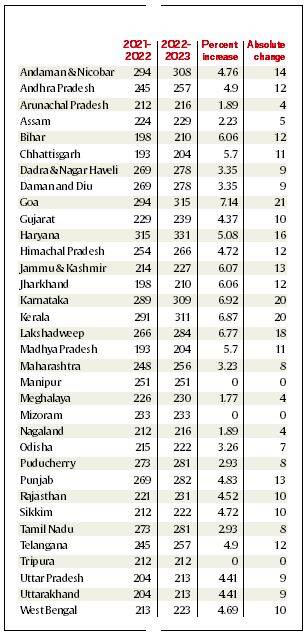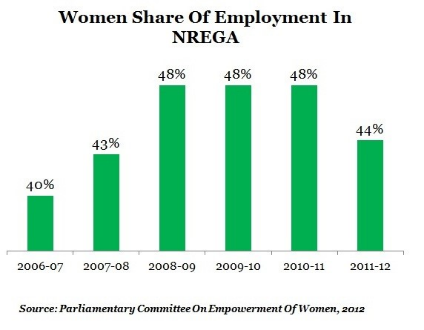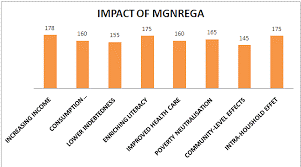Description

Disclaimer: Copyright infringement not intended.
In News
- The Centre has notified fresh wage rates under rural job guarantee programme NREGS for financial year 2022-23.
- The wage rates, notified by Ministry of Rural Development under sub-section (1) of Section 6 of the Mahatma Gandhi National Rural Employment Guarantee Act, 2005, will be effective from April 1.
Major Highlights
- 21 out of 34 states and Union Territories are getting less than 5 per cent increase and 10 states getting more than 5 per cent hike.
- There is no change in the wage rates of three states – Manipur, Mizoram and Tripura.
- Of the 31 states and UTs, which saw a hike in wages, the maximum 7.14 per cent has been recorded in Goa — from Rs 294 per day in 2021-22 to Rs 315 per day in 2022-23.
- The lowest increase of 1.77 per cent is in Meghalaya where the new wage rate has been fixed at Rs 230 per day from the existing Rs 226 per day.
- Only 10 states — Haryana, Chhattisgarh, Madhya Pradesh, Bihar, Jharkhand, Jammu & Kashmir, Lakshadweep, Kerala, Karnataka and Goa — have seen an increase of more than 5 per cent.
- In absolute terms, the NREGS wages have been increased in the range of Rs 4 to Rs 21 per day across 31 states and UTs for 2022-23.
States with highest wage rates
- According to the new wage rates, five states and UTs with the highest NREGS wages are Haryana (Rs 331 per day); Goa (315); Kerala (311); Karnataka (309); and Andaman & Nicobar Islands (308).
States with lowest wage rates
- Five states with lowest NREGS wages are Tripura (212); Bihar (210); Jharkhand (210); Chhattisgarh (204); and Madhya Pradesh (204).

Wage rate fixation under MGNREGA
- Under sub-section (1) of Section 6 of the MGNREGA, 2005, the Union government fixes state-wise wage rates for unskilled manual workers, who work under the rural job guarantee scheme.
- The MGNREGA wage rates are fixed according to changes in the CPI-AL (Consumer Price Index-Agriculture Labour), which reflects the increase in the inflation in rural areas.
MGNREGA
- The Mahatma Gandhi National Rural Employment Guarantee Act (MGNREGA), also known as Mahatma Gandhi National Rural Employment Guarantee Scheme (MNREGS) is Indian legislation enacted on August 25, 2005.
- The MGNREGA provides a legal guarantee for one hundred days of employment in every financial year to adult members of any rural household willing to do public work-related unskilled manual work at the statutory minimum wage.
- The Ministry of Rural Development (MRD), Govt of India is monitoring the entire implementation of this scheme in association with state governments
About MGNREGA:
- Right to Work:Adult members of rural households have a legal right to work under the Act.
- Affirmative action for Women: Women must account for at least one-third of the recipients. Rates must be paid in accordance with the state's Minimum Wages Act of 1948, which specifies wages for agricultural labourers.
- Guarantee of Work in a Timely Manner: Employment must be provided within 15 days of being asked, failing which an 'unemployment allowance' must be paid.
- Decentralized Planning: The Panchayati Raj Institutions (PRIs) are in charge of the planning, implementation, and monitoring of the projects.
- Empowerment of Gram Sabha: Gram Sabhas must recommend the projects to be performed, and at least half of the projects must be carried out by them.
Challenges with MGNREGA:
- Ridiculously low wage rate: MGNREGA wage rates are less than the corresponding state minimum wages.
- Insufficient budget allocation: MGNREGA’s success at the ground level is subject to proper and uninterrupted fund flow to the states.
- Regular payment delays:The Union Ministry of Rural Development considers wages paid once the FTO (Fund Transfer Order) is signed by the second signatory. However, delays take place even in the processing of signed FTOs, for which the Management Information System (MIS) does not calculate compensation.
- Workers penalised for administrative lapses: The ministry withholds wage payments for workers of states that do not meet administrative requirements within the stipulated time period
- The banking puzzle:The rural banks are highly de-capacitated in terms of staff and infrastructure and thus always remain hugely crowded.
- Faulty MIS data: There is a growing pile of evidence on how real-time MIS has made MGNREGA less transparent for workers, reduced accountability of frontline functionaries and aided in centralisation of the programme.
- Non-payment of unemployment allowance: There are a huge number of unemployment allowances being shown in the MIS currently.
- Genuine job cards being deleted to meet 100% DBT targets:Genuine job cards are being randomly deleted, as there is a huge administrative pressure to meet 100 per cent Direct Benefit Transfer (DBT) implementation targets in MGNREGA.
- Too much centralisation weakening local governance:A real-time MIS-based implementation and a centralised payment system has further left the representatives of the Panchayats Raj Institutions with literally no role in implementation, monitoring and grievance redress of MGNREGA schemes.
- Administration not honouring local priorities: However, with the administration almost dictating its implementation, it is literally a burden now for the people and especially for the local elected representatives.
Success of MGNREGA:
- Reduced the distress in agriculture & economy due low agricultural productivity & small land-holding size thus provided them better livelihood opportunities.
- Most of MGREGA work is directed towards building irrigation canals, tanks etc. thus provides resources base for further rural development.
- It has reduced rural distress & intensive urban migration.
- The provisions like work up to 5 km from home, equal wages promotes women empowerment, gender parity & directed towards backward section of society.
- The programme has generated over 1,980 crore person-days. In theshort span of 10 years that the Act has been in existence, it has generated 19.86 billion person-days of employment benefitting 276 million workers, with more than half the jobs going to women workers and almost a 3rd to members of scheduled castes and scheduled tribes.
- It has resulted into social upliftment of all sections including SC/ST. The percentage of Scheduled Caste workers benefitted under the scheme has consistently been about 20% and of Scheduled Tribe workers has been about 17%.
- The legislation has reduced distress migration in traditionally migration-intensive areas.


Government Reforms:
- Geo Tagging of assets: Geo MGNREGA is a path breaking initiative that uses space technology for geo-tagging all assets created under MGNREGA for improved planning, effective monitoring, enhanced visibility and greater transparency.
- Direct benefit transfer: To further streamline the fund flow mechanism and bring down delay in payment of wages, the Ministry of Rural Development has implemented National Electronic Fund Management System (NeFMS) in 21 States and 1 Union Territory.
- Reduction in Number of Registers:Reduction in number of Registers being maintained at Gram Panchayat level to seven simplified Registers from an average of 22 Registers has been implemented.
- Provision of Independent Social Audit:The programme is progressing towards a more independent and empowered system of Social Audit and Internal Audit to ensure growth with accountability through a trained community cadre of social auditors drawn from women SHGs.
- Up skilling of Labour:The Ministry has taken up skill development of the MGNREGA workers through initiatives like Bare Foot Technicians and Project LIFE (Livelihood in Full Employment) in order to move them up the skilling ladder.
Way forward:
- No matter how good a program is, there is always scope for improvisation. For MGNREGA, the Centre must allocate more funds in the budget since the dearth of funds could lead to halting the work, thus causing the interruption.
- Also, the laborers must be paid well in time. The entire scheme could be decentralized so as to make the working a lot better.
- An increase in wages can help in making the scheme more successful. It should also studied why exactly the funds aren’t being utilized properly and take the steps required so as to reach as many people as possible.
- The scheme has been facing many hurdles in recent years and there is an urgent need for the government to look into it and promote the scheme because the recent issues have led to an economic slowdown and have also pushed the country into an unemployment crisis.
https://indianexpress.com/article/india/nregs-wages-revised-less-than-5-per-cent-hike-in-21-states-union-territories-7843460/















